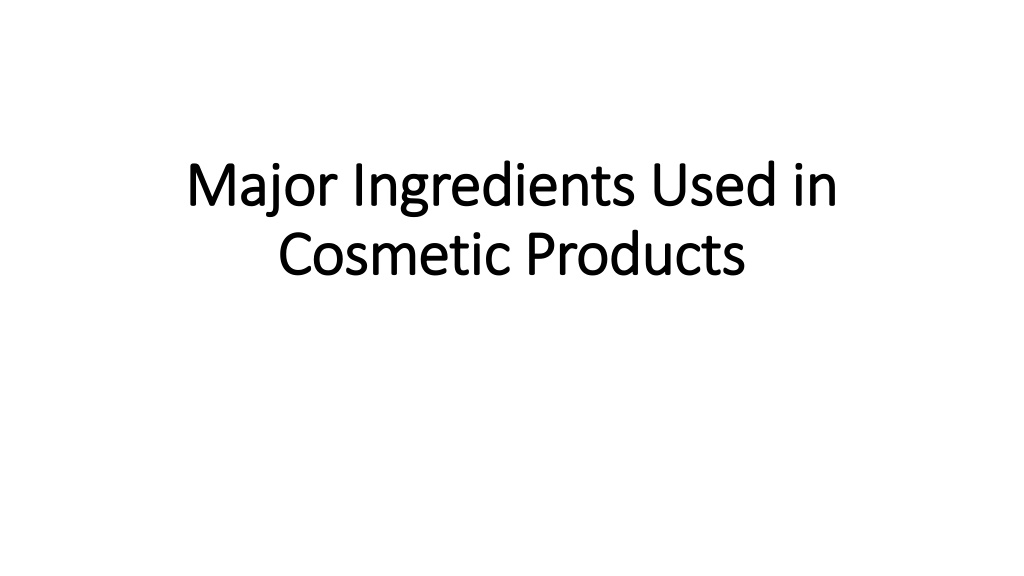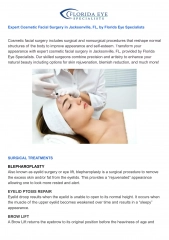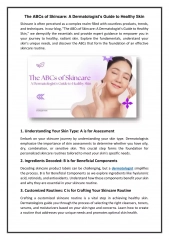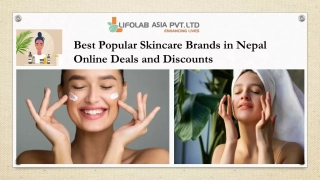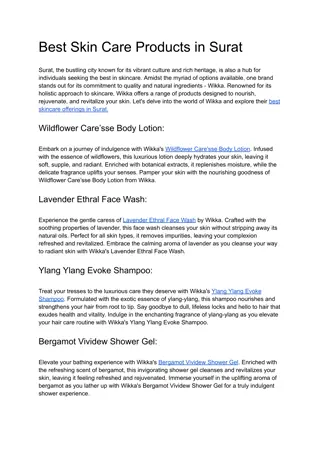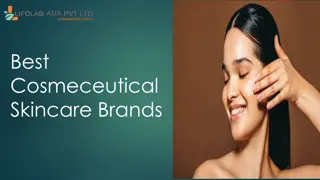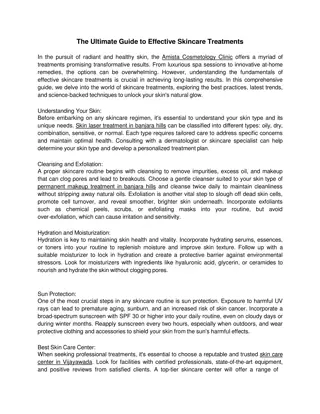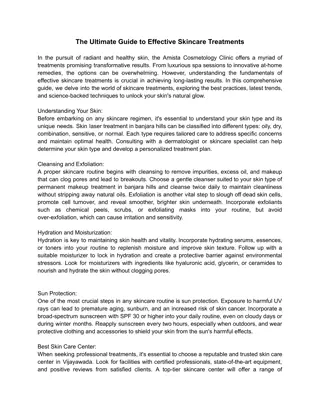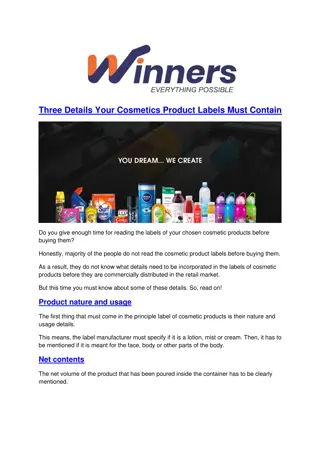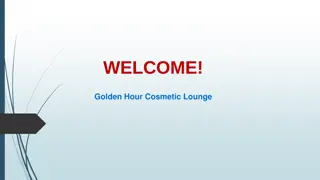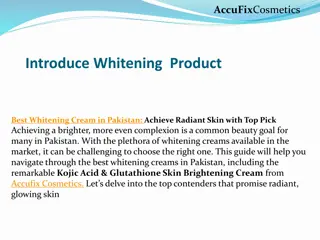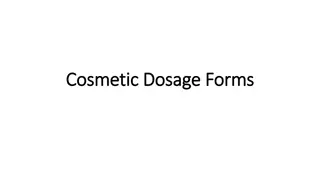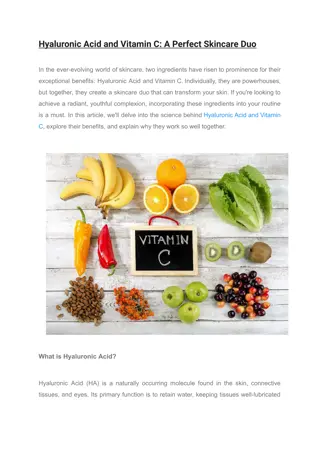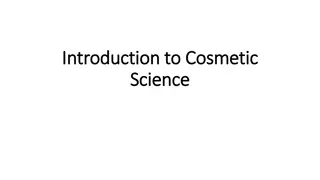Understanding Key Cosmetic Ingredients for Skincare Products
Cosmetic products contain specific cosmetic ingredients aimed at enhancing beauty and appearance. These ingredients have various functions, such as exfoliation, cleaning, and protection. Abrasives are used for scrubbing and peeling in skincare products, while antioxidants provide stability and combat skin aging by protecting against oxidative reactions.
Download Presentation

Please find below an Image/Link to download the presentation.
The content on the website is provided AS IS for your information and personal use only. It may not be sold, licensed, or shared on other websites without obtaining consent from the author. Download presentation by click this link. If you encounter any issues during the download, it is possible that the publisher has removed the file from their server.
E N D
Presentation Transcript
Major Ingredients Used in Major Ingredients Used in Cosmetic Products Cosmetic Products
Cosmetic Ingredients Since cosmetics do not treat any conditions or affect the structure of the skin, they do not contain active ingredients. Cosmetic products contain cosmetic ingredients only. Since OTC drug cosmetic products are used for the prevention, diagnosis, cure, or treatment of a disease; they contain active ingredients, in addition to the cosmetic ingredients. In these products, cosmetic ingredients are referred to as inactive ingredients. As many ingredients have multiple functions, they can belong to more than one group.
STUDENT HAS TO MEMORIZE THE EXAMPLES OF MAJOR INGREDIENTS MENTIONED IN THE PROVIDED HANDOUT DURING THE WHOLE COURSE
ABRASIVES The term abrasive refers to an ingredient that is capable of polishing or cleaning a harder surface by rubbing or grinding. Abrasives are solid particles and are generally used in toothpastes and skin care products, such as face, hand, foot, and body scrubs. Although the effect these ingredients provide is the same, the types used in oral and skin care products are different.
ABRASIVES In skin care formulations, abrasives provide an exfoliating effect, which means that they help rub off and peel the outer layer of the skin, known as the stratum corneum (SC). The skin has its own normal peeling process known as desquamation. However, in certain cases, it can be beneficial to help the skin peel off the dead cells from its surface.
ABRASIVES Abrasives also contribute to the physical cleaning effect and stain removal of toothpastes as well as increase the gloss of the teeth. Abrasives in toothpastes are usually finely ground particles that will not hurt and wear away the enamel but are able to clean the teeth and remove discoloration to a certain extent.
ANTIOXIDANTS Antioxidants, as their name implies, provide protection against oxidative reactions. This property is generally utilized to provide stability to cosmetic formulations and can also be used to slow down skin aging caused by various oxidative mechanisms. Antioxidants can prevent undesirable chemical changes (such as decomposition, rancidity, color change, and odor formation) within a formulation triggered by oxygen in the presence of light, heat, or metal ions.
ANTIOXIDANTS Therefore, they contribute to the stability of cosmetic products. These ingredients are found in the majority of cosmetics and cosmeceutical products, especially in those containing oils, fats, butters, and waxes since these ingredients are generally more sensitive to oxidation reactions than other ingredients.
ANTIOXIDANTS In addition, they are also beneficial for the users skin It is known that oxidative stress initiated by free radicals accelerate skin aging and contribute to the formation of lines and wrinkles, pigmentation, or even malignant processes. We have natural antioxidants and defense mechanisms in our skin to neutralize free radicals; however, applying antioxidants helps inactivate these reactive molecules and prevent symptoms related to sunlight-induced skin aging. Antioxidants for this purpose are often found in skin moisturizing products.
CHELATING AGENTS Chelating agents are molecules with a specific three- dimensional structure that are able to complex with metal ions. Metallic impurities can come from many different sources, including cosmetic ingredients, water system, metallic equipment, and storage containers. If not deactivated, they can deteriorate cosmetic products by reducing clarity, compromising fragrance integrity, and causing rancidity. Chelating agents can help stabilize cosmetics and prevent their deterioration by catching (sequestering) metal ions.
COLOR ADDITIVES Color additives add color to products, making them attractive, appealing, appetizing, and informative. A color additive is: Any material that is a dye, pigment, or other substance when added or applied to a food, drug, or cosmetic or to the human body or any part thereof, is capable of imparting a color thereto.
COLOR ADDITIVES A dye is a chemical compound that is soluble in the particular solvent in which it is dispersed (e.g., oil or water). Examples include indigo and Green 3. A pigment is a component that is insoluble in the particular solvent in which it is dispersed. An example is black iron oxide. A lake are produced by the adsorption of water soluble dye onto a substratum, for example, aluminum, calcium, or barium rendering the colour insoluble in water. These pigments are widely used in lipsticks and nail lacquers. An example is Yellow 5 Al Lake.
Dyes may be said to have an affinity for the substrate they act upon, meaning that they form chemical bonds with the colored surface. Because dyes fully bond with the substrate, they form a smooth surface which results in uniform reflected light and the perception that the dyed surface is more vivid and bright.
COLOR ADDITIVES There is a list available for approved color additives, otherwise known as the positive list. The list specifies areas to which color additives can be applied, as well as limitations, restrictions, and comments on their use. It may happen that a color additive is approved for cosmetic use in general, but not for the eye area. Product manufacturers can only use color additives that have been approved by the FDA for intended uses stated in the regulations that pertain to them. The reason for this approval is that many color additives can cause skin irritation and allergic-type reactions; therefore, not all of them can be used in cosmetics, and there are some restrictions even for approved ingredients.
COLOR ADDITIVES The FDA has not approved any tattoo pigments for injection into the skin. This applies to all tattoo pigments, including those used for ultraviolet (UV) and glow-in-the-dark tattoos. Many pigments used in tattoo inks are industrial-grade colors suitable for printers ink or automobile paint.
FLAVORING AGENTS A flavor is generally described as the sensory impression of food or other substance and is determined by the texture, taste, and smell of a product. Flavoring agents provide a characteristic taste and/or smell to products. In addition, they can also mask bad taste. Overall, they contribute to product acceptance. Flavoring ingredients are primarily used in products that come into contact with the taste buds, including lip care formulations, such as lipstick, as well as dental and oral care products, such as toothpaste.
FRAGRANCES Fragrances are natural or synthetic compounds with a characteristic smell that are added to products to create an aesthetic impression for consumers and make them feel more attractive due to the nice smell. Fragrances can also be added to mask the undesirable odor of one or more of the raw ingredients. Unlike perfumes, which are hydroalcoholic solutions with a high fragrance content sprayed on the skin to transit a pleasant redolence to the user, personal and cosmetic care fragrances have a lower perfume content and are generally used in makeup products and skin and hair care formulations.
FRAGRANCES Fragrances include natural components and synthetic components Nowadays, mainly synthetic fragrances are used to ensure reproducibility. In addition, synthetic fragrances can be stronger, longer lasting, more complex, easier to manufacture and sophisticated, more reproducible from lot to lot, and less expensive than natural fragrances.
MOISTURIZERS The term moisturizer is an umbrella term used to describe ingredients that add moisture to the skin and help retain moisture in the skin. They make the skin feel softer and smoother and reduce roughness, cracking, and irritation. These ingredients are used in many of today s formulations either as a main component of a formulation, for example, in a daily facial moisturizer, or as ingredients that provide additional benefits, for example, in a nail polish remover.
MOISTURIZERS Currently, four subclasses of moisturizers are distinguished Humectants are hygroscopic ingredients. In general, they can serve two functions: They can contribute to skin hydration by drawing water from the deeper layers of the epidermis and dermis to the outer layer of the skin (SC). They inhibit water evaporation from cosmetic products, i.e., provide protection against drying out.
MOISTURIZERS Emollients replenish oils and lipids in the skin. They soften and smooth the skin by filling void spaces on the skin surface and replacing lost lipids in the SC. They also provide protection and lubrication on the skin surface, minimize chafing, and enhance the skin s aesthetic properties. Occlusives are hydrophobic in nature and form a water- repellent layer over the skin. It physically blocks, or at least retards, water loss through the skin.
MOISTURIZERS Enhancers of the skin barrier (otherwise known as skin rejuvenators) help restore, protect, and enhance the skin s barrier function. Additionally, they create a film over the skin surface that aesthetically smoothens the skin and stretches out fine lines.
pH BUFFERS The pH buffers can change the pH of formulations. pH adjustment may be necessary in formulations for many reasons. Examples include: 1.Matching the formulation s pH with that of the application surface, 2.Stabilizing formulations since certain ingredients are stable at specific pH values only 3.Thickening formulations as certain thickeners must be neutralized in order to achieve optimum viscosity. An example for these types of thickeners is the carbomers.
PLASTICIZERS Plasticizers are ingredients that can soften films and impart flexibility to films, such as nail polish film or hair spray film, as the film dries. Often, the developing film is very rigid and brittle, which makes nail polish sensitive to chipping and cracking or hair spray film stiff and brittle. Plasticizers can help prevent these undesired effects. Plasticizers are often used in nail polishes, nail hardeners, sunscreens, and film-former-based hair styling products.
PRESERVATIVES Preservatives are used to prevent undesirable growth of molds, yeast, and bacteria in liquid, semisolid, and powder products. Their use is especially important in water-based products since water provides an ideal environment for microbial growth. The mechanism of action and range of efficacy usually vary among the different types of preservatives. Therefore, they are generally used in combination with each other to provide protection against a wide variety of microorganisms.
PROPELLANTS Propellants are added to aerosol formulations to maintain a suitable pressure within the aerosol can and expel the content of the container when the valve is open. They are usually compressed or liquefied gases. Propellants are used in aerosol products, such as shaving creams, hair sprays, antiperspirants, and sunscreen products, among others.
SOLVENTS They can contribute to the stability of formulations, regulate evaporation rate, provide a cooling effect, aid in product application, modify the skin feel, modify the viscosity, influence the film-forming properties, and have many other functions. The solubility of an ingredient in a given solvent is largely a function of the polarity of the solvent. Solvents work under the general rule of like dissolves like.
SURFACTANTS Surfactants, also known as surface active ingredients, are the most widely used ingredients in cosmetics and cosmeticeutical products. They have a very unique chemical structure, including both a hydrophilic (i.e., water loving) and a hydrophobic (i.e., oil loving) portion, which enables them to be dissolved both in water and in oil. Surfactants can lower the surface tension between two liquids or between a liquid and a solid, making them suitable for many applications.
SURFACTANTS They contribute to the formulation, stability, and applicability of personal care and cosmetic products. They can fulfill a variety of functions including: 1. Emulsification 2. Solubilization 3. Cleansing 4. Foaming and foam boosting 5. Wetting 6. Conditioning 7. Preserving 8. Stabilizing 9. Controlling viscosity and many others.
SURFACTANTS Anionic surfactants contain a negative charge in their hydrophilic head. Anionic surfactants are typically utilized for their foaming and excellent cleaning properties. Their major drawback is the irritating potential, especially for sulfates, which may cause concerns for many consumers. Cationic surfactants contain a positive charge in their hydrophilic head. They represent the most powerful conditioning agents for the skin and hair. As the overall surface charge of the skin and hair is negative, cationic surfactants are electrostatically attracted to these negative sites.
SURFACTANTS Amphoteric surfactants have both a negative and a positive charge in their hydrophilic head. They have good cleansing, bactericidal, bacteriostatic, lathering, and softening properties and are able to stabilize and induce foam formation. Therefore, they are used in shampoos, baby products, and aerosols.
SURFACTANTS Nonionic surfactants do not dissociate into ions, and their hydrophilic head does not carry any charge. They are the most frequently used surfactants in cosmetics and cosmeceutical products. Their application areas include emulsion stabilization, conditioning, and solubilization. Their advantages over other types include independency from pH and the presence of electrolytes as well as low irritation potential and compatibility with other types.
Surfactants are typically characterized by their HLB numbers hydrophile lipophile balance . The HLB system uses a scale of 1 20 based on the affinity of the surfactant to oil and water; the higher the HLB value, the more water soluble the surfactant. In general, emulsifiers with HLB values of 1 3 are antifoaming agents, Those with values of 4 6 are water-in-oil (W/O) emulsifiers Those with values of 7 9 are wetting agents, Those with values of 8 18 are oil-in-water (O/W) emulsifiers Those with values of 13 15 are cleansing agents Those with values of 10 18 are solubilizing agents
SWEETENERS Sweeteners provide a sweet flavor and contribute to product acceptance in products that come into direct contact with the taste buds. These products include toothpastes, mouthwashes, lipsticks, lip balms, and lip glosses. Sweeteners are generally categorized into two major groups: 1. True sweeteners (also known as no-calorie sweeteners) that do not provide any calories 2. low-calorie sweeteners that add some calories to products. They are usually used in combination with flavors as the combination of flavors and sweeteners provides an acceptable and attractive taste for the formulations.
THICKENERS Thickeners are ingredients that can increase the viscosity of products. They also improve stability, modify appearance and products aesthetics, improve applicability, and modify the rheology of a product. Thickeners can also be used to build viscosity in suspensions and act as suspending agents We generally differentiate between viscosity-increasing agents for aqueous systems, which increase the viscosity of the aqueous (water) phase, such as the water phase of an O/W emulsion, and for nonaqueous systems, which increase the thickness of the oil phase of cosmetic products, such as the oil phase of a W/O emulsion.
THICKENERS For the selection of thickeners, a variety of factors should be taken into consideration, including: 1.The products use 2.Application surface 3.Compatibility with other ingredients in the formula 4.pH (certain thickeners, e.G., Carbomers, are alkali swellable, and they need an alkaline ph to reach optimum viscosity; therefore, they cannot be used in an acidic environment) 5.Clarity
THICKENERS 6. The presence of electrolytes 7.Temperature during processing (waxes have to be melted in order to be mixed with oils; if a product is made without heating, waxes cannot be used) 8.Shear during processing (some ingredients, such as carbomer, require shear in order to be activated and gain optimum viscosity, while others may be sensitive for shearing, such as fumed silica).
ACTIVE INGREDIENT The major active ingredient types (without completeness) that can be found in various types of OTC drug cosmetic products. Anti-Acne Ingredients The ingredients have abrasive, exfoliating (peeling), and antiseptic effects to remove the excess amount of oil and peel the skin. These ingredients can be found in skin care products, such as facial washes, toners, and moisturizers, as well as in makeup products, such as concealers.
ACTIVE INGREDIENT Anticaries Ingredients These ingredients are used to prevent caries; strengthen the tooth enamel and slow down the formation of an invisible, sticky film (called plaque) that leads to caries formation; as well as restore and harden the teeth. These ingredients are available in all types of oral care products, including toothpaste, toothpaste gel, and mouthwash.
ACTIVE INGREDIENT Antidandruff Ingredients These ingredients have antimicrobial properties, and some of them also have exfoliating properties. Generally, they are formulated into shampoos. Antiperspirant Ingredients Antiperspirants affect the function of the body by reducing the amount of sweat that reaches the skin surface and not just masking bad body odor as do deodorants do. Underarm odor is caused by the bacterial breakdown of sweat
Skin Protectant Ingredients This category includes several subcategories, such as astringents, lip protectant ingredients, and skin protectant ingredients. Astringents are applied to the skin or mucous membranes for a local and limited protein coagulant effect. They are commonly used in facial toners and aftershave solutions to tighten pores. Lip protectants temporarily prevent dryness and help relieve chapping They are traditionally called lip balms. Ingredients used as lip protectants moisturize the lips as well as provide protection against further water loss.
Skin protectants temporarily protect injured or exposed skin or mucous membrane surfaces from harmful or annoying stimuli. Examples for skin protectants are the same as those for lip protectants. SunscreensSunscreens (also known as UV filters) protect the skin from the harmful radiation of the sun
